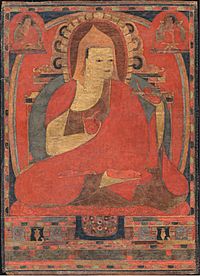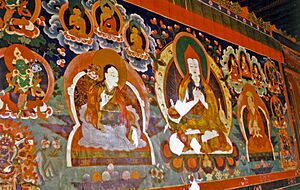Atiśa facts for kids
Quick facts for kids
Atiśa Dīpankara Śrījñāna
|
|
|---|---|
| অতীশ দীপংকর শ্রীজ্ঞান | |

This portrait of Atiśa originated from a Kadam monastery in Tibet and was gifted to New York's Metropolitan Museum of Art in 1993. In this depiction, Atiśa holds a long, thin palm-leaf manuscript with his left hand, probably symbolising one of the many important texts he wrote, while making the gesture of teaching with his right hand.
|
|
| Born | 982 |
| Died | 1054 (aged 71–72) Nyêtang, Tibet
|
| Other names | Chandragarva Shri |
| Occupation | Buddhist teacher |
| Known for | Abbot of the Vikramashila monastery. The major figure in the establishment of the Sarma lineages in Tibet. |
| Children | None |
| Parent(s) | Kalyan Shri and Prabhabati |
|
Basic terms |
|
|
People |
|
|
Schools |
|
|
Practices |
|
|
study Dharma |
|
Atiśa Dīpankara Śrījñāna (Bengali: অতীশ দীপংকর শ্রীজ্ঞান, romanized: otish dipônkor sriggan; Standard Tibetan: ཇོ་བོ་རྗེ་དཔལ་ལྡན་ཨ་ཏི་ཤ།, romanized: Jowoje Palden Atisha; Chinese: 燃燈吉祥智; pinyin: Rándēng Jíxiángzhì) (982–1054) was a very important Buddhist teacher and leader. He is well-known for his work at the Vikramashila monastery in Bihar, India. Atiśa played a huge role in spreading Mahayana and Vajrayana Buddhism across Asia in the 11th century. His ideas influenced Buddhist thinkers from Tibet all the way to Sumatra. Many people see him as one of the most important figures in classical Buddhism.
Atiśa's main student, Dromtön, started the Kadam school. This was one of the new schools of Tibetan Buddhism. Later, the Gelug tradition took over, using Kadam's teachings and monasteries. In 2004, Atiśa was voted the 18th greatest Bengali of all time in a BBC poll.
Contents
Early Life of Atiśa
Growing Up in the Palace
Atiśa was likely born in Bikrampur, which was the capital of the Pala Empire. This ancient city in southeast Bengal is now in the Munshiganj District of Bangladesh. It was a famous center for Buddhist culture, learning, and politics.
Just like Gautama Buddha, Atiśa was born into a royal family. His father was King Kalyana Shri, and his mother was Shri Prabhavati. King Srichandra was his grandfather. Atiśa was one of three royal brothers. For the first part of his life, he was known as Candragarbha. He only received the name Atiśa when he traveled to Guge and met King Jangchup Ö.
Atiśa's Studies and Teachers
Tibetan stories say that Atiśa became a monk at age twenty-eight. He was taught by Abbot Śīlarakṣita. Atiśa studied almost all the Buddhist and non-Buddhist teachings of his time. This included ideas from Vaishnavism, Shaivism, and other Hindu practices.
He also learned sixty-four different types of art, music, and logic. He finished these studies by the time he was twenty-two. Atiśa had more than 150 teachers. One of his most important teachers was Dharmakīrtiśrī. He studied and shared three main Buddhist teachings:
- The Lineage of Profound Action from Asaṅga and Vasubandhu.
- The Lineage of Profound View from Nagarjuna and Candrakīrti.
- The Lineage of Profound Experience from Tilopa and Naropa.
Atiśa's Journeys and Teachings
Tibetan records say that Atiśa spent 12 years in Sumatra, part of the Srivijaya empire. He returned to India in 1025 CE. This was the same year that Rajendra Chola I of the Chola dynasty invaded Sumatra.
When Atiśa came back to India, he became very famous. People admired his teachings and his skills in debates and philosophy. He was known for winning debates against non-Buddhist thinkers three times. If he saw that Buddhism was being misunderstood or weakened, he would quickly make changes to fix it. Soon, he was made the head, or abbot, of the Vikramashila monastery. This monastery was built by Emperor Dharmapala.
Atiśa's return from Suvarnabhumi (where he had been studying) and his growing fame in India happened during a time when Buddhist culture was thriving. Atiśa's influence helped these developments.
According to old stories, a king named Langdarma had stopped Buddhist teachings and hurt its followers for over seventy years. The Blue Annals says that a new king of Guge, Yeshe-Ö, sent his scholars to learn and translate Sanskrit Buddhist texts. One of these scholars was Naktso. Naktso was later sent to Vikramashila to study Sanskrit and ask Atiśa to come teach Buddhism in Tibet.
Atiśa traveled with Naktso and Gya Lōtsawa through Nepal to Tolung. Tolung was the capital of the Purang Kingdom. (Gya Lōtsawa died before reaching Tolung.) On his way, he is said to have met Marpa Lōtsawa. Atiśa stayed in Tolung for three years. There, he wrote his most important book, Bodhipathapradīpa. This book is also called Lamp for the Path to Enlightenment.
This short book, with sixty-seven verses, explains the entire Buddhist path. It talks about the three main ways of practicing Buddhism: Hīnayāna, Mahāyāna, and Vajrayāna. This book became a model for later texts called Lamrim (meaning Stages of the Path). It was especially important for Tsongkhapa's Lamrim writings. In Tolung, Atiśa also met Dromtön, who became his main student. Dromtön was seen as someone who upheld ethical standards and carried on Atiśa's tantric teachings.
According to Jamgon Kongtrul, Atiśa found many Sanskrit texts at Pekar Kordzoling, the library of Samye. He said that the way Vajrayana Buddhism had spread in Tibet was amazing, even more than in India. After saying this, he respectfully put his hands together and praised the great kings, translators, and scholars of the past.
Atiśa's Writings
Here are some of his most famous books:
- Bodhipathapradīpa (Wylie: byang chub lam gyi sgron ma)
- Bodhipathapradipapanjikanama (his own comments on byang chub lam gyi sgron ma)
- Charyasamgrahapradipa (includes some devotional songs by Atiśa)
- Satyadvayavatara
- Bodhisattvamanyavali
- Madhyamakaratnapradipa
- Mahayanapathasadhanasangraha
- Shiksasamuccaya Abhisamya
- Prajnaparamitapindarthapradipa
- Ekavirasadhana
- Vimalaratnalekha (a letter in Sanskrit to Nayapala, king of Magadha)
See also
 In Spanish: Atisha para niños
In Spanish: Atisha para niños



